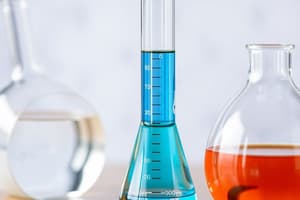Podcast
Questions and Answers
What is the term for the simplest whole-number ratio of atoms in a compound?
What is the term for the simplest whole-number ratio of atoms in a compound?
- Empirical Formula (correct)
- Molecular Formula
- Structural Formula
- Lewis Structure
What is the term for the study of the quantitative relationships between reactants and products in chemical reactions?
What is the term for the study of the quantitative relationships between reactants and products in chemical reactions?
- Atomic Structure
- Thermodynamics
- Chemical Equilibrium
- Stoichiometry (correct)
Which of the following is NOT a key concept in Stoichiometry?
Which of the following is NOT a key concept in Stoichiometry?
- Moles
- Electron Configuration (correct)
- Empirical Formula
- Molar Mass
What is the unit of measurement that represents 6.022 x 10^23 particles (atoms or molecules)?
What is the unit of measurement that represents 6.022 x 10^23 particles (atoms or molecules)?
According to the Rutherford Model, what is the structure of an atom?
According to the Rutherford Model, what is the structure of an atom?
What is the term for the particles with no charge in the nucleus?
What is the term for the particles with no charge in the nucleus?
What is the term for the number of protons in an atom's nucleus?
What is the term for the number of protons in an atom's nucleus?
What is the term for atoms of the same element with different mass numbers?
What is the term for atoms of the same element with different mass numbers?
What is the principle that states electrons occupy the lowest available energy level?
What is the principle that states electrons occupy the lowest available energy level?
What is the term for the electrons in the outermost energy level?
What is the term for the electrons in the outermost energy level?
Flashcards are hidden until you start studying
Study Notes
Stoichiometry
- Definition: Stoichiometry is the study of the quantitative relationships between reactants and products in chemical reactions.
- Key Concepts:
- Moles: a unit of measurement that represents 6.022 x 10^23 particles (atoms or molecules)
- Molar Mass: the mass of one mole of a substance (in grams)
- Empirical Formula: the simplest whole-number ratio of atoms in a compound
- Molecular Formula: the actual number of atoms in a molecule
- Stoichiometric Calculations:
- Mole-Mole Calculations: relate the number of moles of reactants to the number of moles of products
- Mass-Mass Calculations: relate the mass of reactants to the mass of products
- Limiting Reactant: the reactant that determines the amount of product formed
- Percent Yield: the percentage of the theoretical amount of product that is actually formed
Atomic Structure
- Atomic Model:
- Rutherford Model: an atom consists of a small, dense nucleus surrounded by electrons
- Bohr Model: electrons occupy specific energy levels (shells) around the nucleus
- Subatomic Particles:
- Protons: positively charged particles in the nucleus
- Neutrons: particles with no charge in the nucleus
- Electrons: negatively charged particles that orbit the nucleus
- Atomic Number and Mass Number:
- Atomic Number (Z): the number of protons in an atom's nucleus
- Mass Number (A): the sum of protons and neutrons in an atom's nucleus
- Isotopes: atoms of the same element with different mass numbers (different number of neutrons)
- Electron Configuration:
- Valence Electrons: electrons in the outermost energy level
- Core Electrons: electrons in the inner energy levels
- Aufbau Principle: electrons occupy the lowest available energy level
- Hund's Rule: electrons occupy degenerate orbitals with parallel spins
Stoichiometry
- Stoichiometry is the study of quantitative relationships between reactants and products in chemical reactions.
- A mole (mol) is a unit of measurement that represents 6.022 x 10^23 particles (atoms or molecules).
- Molar mass is the mass of one mole of a substance, measured in grams.
- Empirical formula is the simplest whole-number ratio of atoms in a compound.
- Molecular formula is the actual number of atoms in a molecule.
- Stoichiometric calculations involve mole-mole and mass-mass calculations.
- Mole-mole calculations relate the number of moles of reactants to the number of moles of products.
- Mass-mass calculations relate the mass of reactants to the mass of products.
- Limiting reactant is the reactant that determines the amount of product formed.
- Percent yield is the percentage of the theoretical amount of product that is actually formed.
Atomic Structure
- The Rutherford Model of the atom consists of a small, dense nucleus surrounded by electrons.
- The Bohr Model of the atom states that electrons occupy specific energy levels (shells) around the nucleus.
- Protons are positively charged particles in the nucleus of an atom.
- Neutrons have no charge and are found in the nucleus of an atom.
- Electrons are negatively charged particles that orbit the nucleus of an atom.
- Atomic number (Z) is the number of protons in an atom's nucleus.
- Mass number (A) is the sum of protons and neutrons in an atom's nucleus.
- Isotopes are atoms of the same element with different mass numbers (different number of neutrons).
- Electron configuration involves the arrangement of electrons in energy levels around the nucleus.
- Valence electrons are electrons in the outermost energy level.
- Core electrons are electrons in the inner energy levels.
- The Aufbau Principle states that electrons occupy the lowest available energy level.
- Hund's Rule states that electrons occupy degenerate orbitals with parallel spins.
Studying That Suits You
Use AI to generate personalized quizzes and flashcards to suit your learning preferences.




